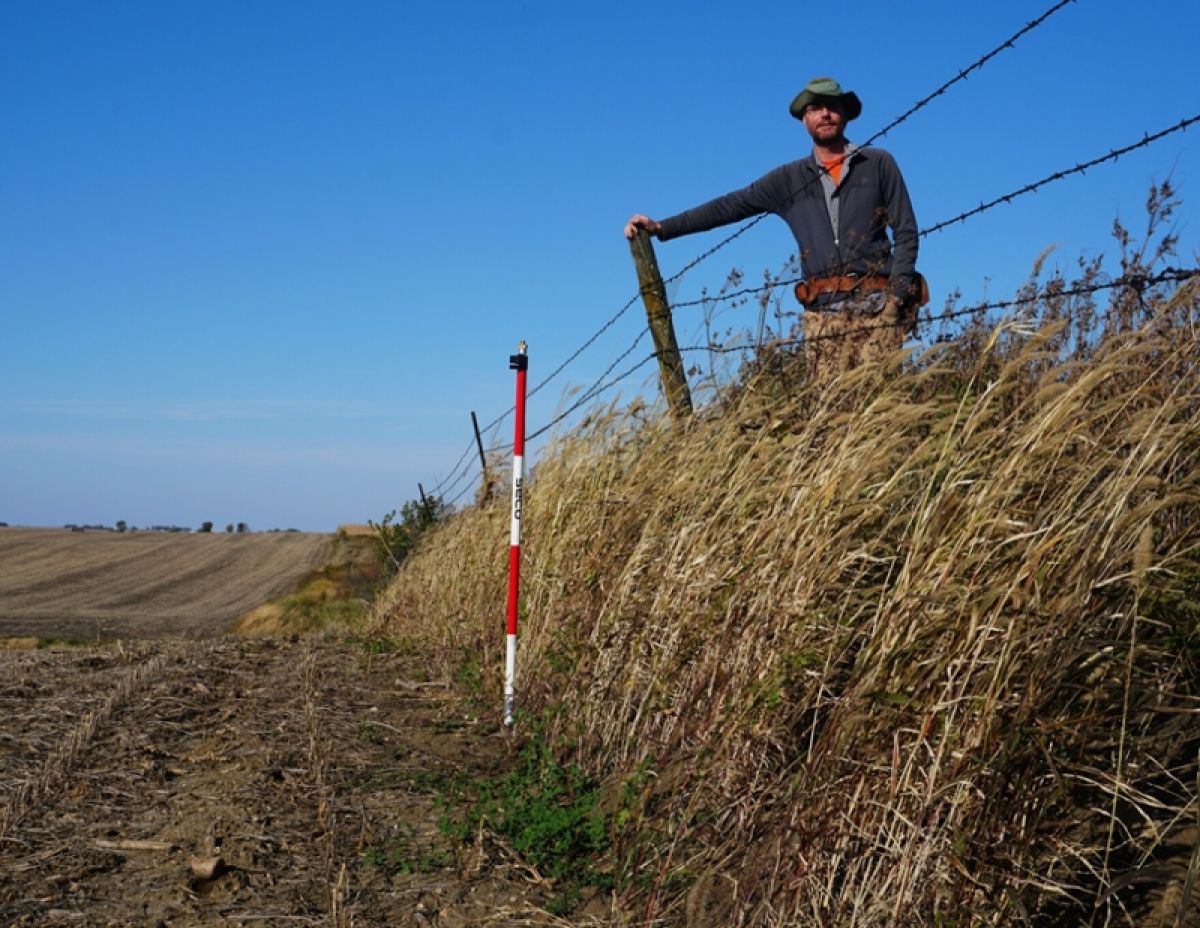
University of Massachusetts Amherst geosciences professor Isaac Larsen stands on the drop-off separating the native prairie from farmland at Stinson Prairie, Iowa. (Umass Amherst)
A few years ago, Isaac Larsen attended a wedding at a pioneer church in Minnesota. After the ceremony, he wandered around a cemetery by the church.
He noticed the cemetery, which had never been tilled, was at least a foot higher than a corn field just on the other side of a fence.
“That was one of those ‘lightbulb’ moments that told me that a lot of soil had been eroded from that field since the founding of the church,” Larsen said.
The University of Massachusetts Amherst geosciences professor and his co-researchers have released a new study that found topsoil in the Midwest is eroding at an average rate of 1.9 millimeters per year. They measured elevation differences between native prairie and farm fields at about 20 sites, the majority in central Iowa, with some in Illinois, Minnesota, South Dakota, Kansas and Nebraska.
The researchers estimate the Midwest has lost 57.6 billion metric tons of topsoil since farmers began tilling 160 years ago. This erosion, Larsen said, makes it more difficult and more expensive to grow crops.
“We’re going to need to feed more people in the future,” he said, “and degraded soils that have lost their organic rich horizons just aren’t as productive.”
The solution, Larsen said, is to adopt no-till farming. “It’s not some unsolvable problem.”
In Iowa, never-farmed prairie is one of the rarest ecosystems besides oak savanna, said Emily Martin, the conservation programs coordinator for the Iowa Natural Heritage Foundation. The group helped the researchers identify prairie sites throughout the state where they could take measurements.
Martin said the study’s findings that topsoil is eroding at an average rate of 1.9 millimeters per year is “a shocking number. But it’s not surprising either.” She said conservation groups like the Iowa Natural Heritage Foundation need to work with farmers to protect land and further integrate conservation with agriculture.
As topsoil thins, soil productivity declines. Iowa State University agronomy professor Richard Cruse said farmers can lose 50%-70% of their yield potential because of the loss of topsoil.
“When you’re talking about that, you’re also talking about sustainability or resilience, the potential for an area to produce under good times and bad,” Cruse said. “The loss of soil reduces that capacity.”
Cruse, who said he thought the study was “done pretty well,” added that topsoil isn’t gone. Most of the topsoil that moves because of erosion is deposited in the same field downslope. But that still affects production potential, he said.
“The loss from the hillslope, where it is progressively thinning, has a much bigger negative impact on production than does the accumulation of that on the soil downslope which already has more than adequate topsoil to produce,” he said.
Cruse added a little less than a third of Iowa’s soils are no-tilled, so “it is realistic” to stop tillage, he said.
“By and large, we have the technology now to make no-till work or something that approximates it, maybe strip till,” Cruse said. “So it's realistic. It’s more challenging with some soils than others.”
Some farmers are already no-till. The U.S. Department of Agriculture said in August 2021 that 21% of all cultivated cropland acres are continuous no-till.
Austin Charlson grows corn and soybeans in Wright County, Iowa. About 75%-85% of his acres have been no-till for seven years – primarily because when he started farming he had no equipment. He says he’s noticed a difference in the soil of his no-till acres.
“I'll take a spade out in the field and I'll step in, dig out a section of soil and the texture is evolving,” Charlson said. “For one thing, there's more earthworm holes, so that promotes water going down and oxygen going down to the roots. Earthworms add fertility and they help break up the soil.”
Charlson said his soils are “more crumbly” whereas other soils he’s seen on a field that’s been tilled and cultivated are more granular, “really fine like a powder,” he said.
“Right now we're in drought-ish conditions, but no-till is helping to reserve my water reserves. It’s helping to retain my subsoil moisture, or the water that my crops need to grow,” he said.
But Charlson said he has experienced some frustrations with no-till. Depending on the moisture conditions, the soil can be hard without tillage, which doesn’t allow for a good seedbed, he said.
“It’s been a challenge,” he said. “I’m constantly learning, I’m trying to modify things and make it better.”
The soil erosion study was published in the journal Earth’s Future.
Follow Katie on Twitter: @katiepeikes
Harvest Public Media reports on food systems, agriculture and rural issues through a collaborative network of NPR stations throughout the Midwest and Plains.













